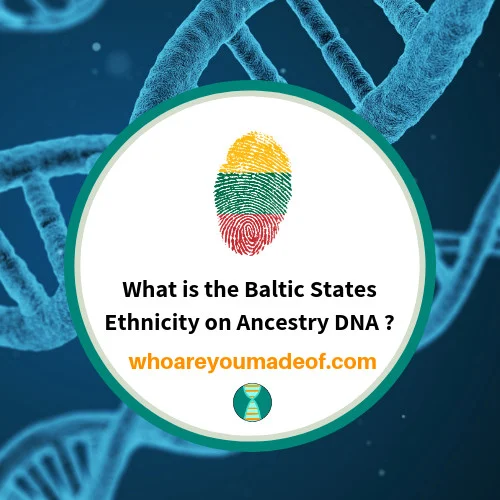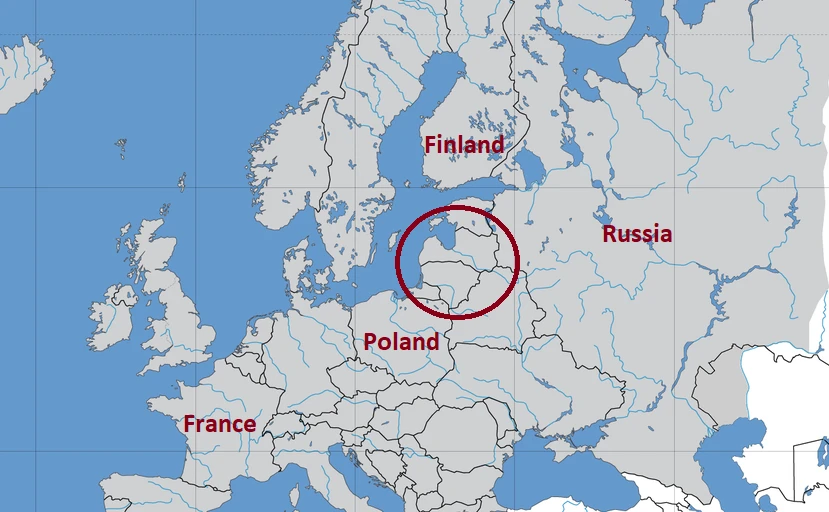Did you find the Baltic State ethnicity region in your Ancestry DNA results? Were you surprised, or were you expecting it? In this post, I'll discuss the location of this ethnicity region, how you might have inherited this particular ethnicity region, and how to get started tracing your Baltic States ancestors.

From a personal standpoint, I include myself in the group that was surprised to see this ethnicity region in my DNA results. I don't have ancestors from any place that I would have considered to be part of this region.
At least three of my great-great grandparents were Polish, however, and after researching this region, it seems well within the range of normal to have found DNA matching this region in my own results.
Important note: This DNA region is new and was added to Ancestry DNA ethnicity results after the Ancestry DNA 2018 update. Previously, people with DNA from this area would have been included in the Europe East DNA ethnicity.
Everyone who had previously tested with Ancestry before the update gets their ethnicity updated for free, so be sure to check back periodically. It's great that they have added this more specific region since it provides Ancestry DNA customers with greater detail.
Where is the Baltic States ethnicity region located?
The Baltic States DNA region is located between Poland and Russia on the Baltic Sea. While no one is sure how the Baltic Sea got its name, the root of the word "Baltic" can be traced back more than a thousand years, and the countries located along the sea have come to be known as the Baltic States.
People who live in this region have very distinct language and cultures. Their languages are part of the Baltic Language group, which is related to the Proto-Baltic-Slavic family of languages.
In the map below, you can see the primarily area covered by this DNA region. It is important to note that DNA from this region might be found in nearby areas, so if your known ancestors aren't from the region marked on the map, it could be that your Baltic States ancestors are from further back in history.

Map credit: Derivative of Public Domain image
Which countries are in the Baltic States ethnicity region located?
The primary group of countries where the Baltic States ethnicity region is located includes Estonia, Latvia, and Lithuania. Because of the nature of DNA and human movement, we can also commonly find at least some DNA from this region in Belarus, Russia, Poland and the Ukraine.
How far back is my Baltic State ancestor?
There is no hard and fast way to figure out how far back your "100%" Baltic State ancestor might be, but the percentage of Baltic State DNA that you have in your results can help you figure out about how far back in your family tree you should look to find your Baltic roots.
I would caution that we shouldn't always think about our ancestors as having been "100%" of one particular region. Depending on what part of the world our ancestors lived in, they could have been more admixed, or less admixed than we are.
I like to assume that my ancestors likely had DNA from neighboring regions, and might have had DNA from places that were further away.
Someone who has a high percentage of Baltic in their ancestry (over 50%) can assume that either one parent was nearly 100% Baltic, or that both parents had some Baltic, and they inherited enough from both to equal 50%.
Most people who have very high percentages of a particular DNA region have a fairly good idea as to how they inherited it (i.e. their parents or grand-parents were from Lithuania or Estonia).
Those people with small amounts of Baltic State DNA might not be able to use the simple formula of doubling the percentage each generation to get back to the person who was likely 100% Baltic.
For example, I have 2% Baltic State DNA. If I double this percentage every generation (2%, 4%, 8%, 16%, 32%, 64% ==> 100% Baltic ancestor), this would mean that one of my great-great-great grandparents was from the Baltic State region.
I don't know who all of my great-great-great grandparents are, but I do know who all of my great-great grandparents are, and I have found no evidence that any of them were born to parents from the Baltic State region.
More likely, my Baltic ancestry is many generations ago - many more than I will be likely to determine. DNA isn't passed down in equal 50% percentages every generation, instead, it is inherited by a random process where we inherit 50% of our parent's DNA, but we have no way to know which 50% we'll inherit.
Sometimes, we can get more than the 50% of a particular ethnicity region from our parents, and other times we might get a smaller portion of it. For example, my mother has 8% Baltic State DNA, and I only got 2%.
Is it possible to trace my Baltic States ancestry?
It's possible to determine which of your ancestors likely contributed your Baltic State DNA. As I always recommend, the best way to know where your Baltic State ancestry came from is to start building a family tree.
Start with yourself, and include your parents, grandparents, and great-grandparents.
Chances are, once you build a small tree with only three generations back from yourself, you'll have a good idea of which direction to look for your Baltic State ancestors.
The smaller the percentage of Baltic State ancestry, the further back you'll have to build your tree to get clues about where your Baltic State ancestors might have come from.
For example, I have two Polish great-great grandparents. I know that the Polish-Lithuanian Commonwealth existed from 1569-1795, and that my Polish great-grandfather lived in Tadajewo, Poland, which is about a two-hour drive south of Poland's Baltic coast and about twice that far to the border with Lithuania.
My Polish great-great grandmother was from southern Poland, as far as I can tell, and seemingly less likely to have Baltic State DNA. Either way, I feel confident that my Baltic State roots extend from one or both of these Polish ancestors.
I love building my family trees on Ancestry because it's free to get started. It's a lot easier to get access to records and documents to build your tree if you have a subscription, which I recommend.
Conclusion
I hope that you have a better understanding of the background of this DNA region, an idea as to how you may have inherited DNA matching the Baltic States area, and a good plan for learning about your ancestors after reading this post.
If you have any questions about something that you read here, or would like to share your own experience finding this DNA region in your results, I would love to hear from you in the discussion below.
Thanks for stopping by!


Michelle
Sunday 6th of August 2023
Hi, I have just received my DNA results from MyHeritage and was surprised to see that I have only 4% Baltic DNA when my father was Polish... and so were many of his ancestors. I read that if one of your parents is from this region you should have up around 50% Baltic DNA?? I can't imagine that I was not my 'father's' child as I look so much like his family... so is this reading probably faulty?
It appears I'm almost 60% British (about 30% English) and about 8% Scandinaviana (Norway, Finland, Sweden) which I didn't expect either.
Thanks, Michelle Klepper
CLARE
Sunday 16th of July 2023
I have 86%irish 4% scandanavian and 10% baltic , the Scandinavian comes as no surprise but was wondering about the baltic?
Bob
Thursday 18th of January 2024
@CLARE, well Clare just wondering what part of Ireland do you hail from its just my mother has near exactly the same results where from Wexford thanks
Katrin
Monday 20th of March 2023
This information is not quite right when it comes to language groups and migration. Estonia is part of Baltic states but its language is Finnic and is distinctively different than Latvian and Lithuanian. Estonians are closely related to Finns and distantly to Hungarians. Please correct your mistakes!
Mike M
Friday 30th of December 2022
My numbers from Ancestry, Baltics 93%, West Lithuania, Central Lithuania Eastern Europe & Russia 5%, Wales 2%. My Family Tree results are similar at Baltic 94%, Scandinavia 6%. My maternal GGP were both born in Lithuania, my mothers paternal GP have all French surnames from Quebec Canada. On my bio father's side my GM was said to be Lithuanian but my bio father's father, my GF's family was said to be from Great Britain. I am proud to be of Lithuanian decent, but confused how my Mom managed to become pregnant from someone who contributed 43% Baltic heritage to my ethnicity. Where there early migrations from the Baltics to both French Canada and to Great Britain? More questions than answers.
LeslieK
Thursday 6th of October 2022
Great article! I am 39% Baltic and 11% eastern European-Poland and 27% Scottish-what a mixed bag. I believe my Grandfather on my moms side was from the upper part of Poland that was part of Lithuania many years ago and considered himself Polish and spoke it and was part of the club in town and my grandmother and great grandmother-Poland on Mom's side of the family. I was shocked I had so much Baltic background and also have a bit of Welsh and England also which was a surprise!